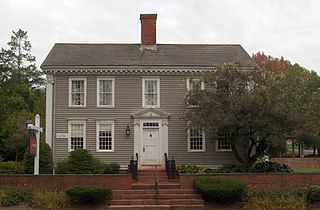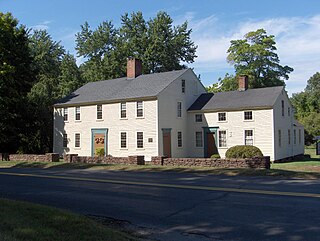
Simsbury is a town in Hartford County, Connecticut, United States. The population was 24,517 at the 2020 census. The town was incorporated as Connecticut's 21st town in May 1670.

The Captain Elisha Phelps House is a historic house museum at 800 Hopmeadow Street in Simsbury, Connecticut. The colonial-era house was built by David Phelps in 1711. His son Elisha Phelps received the land from his father and expanded the house in 1771. Elisha Phelps along with his brother Noah Phelps and others took part in the capture of Fort Ticonderoga in 1775. Capt. Phelps was appointed as commissary of the Northern Department by the Continental Congress.

The Simsbury Center Historic District is a 75-acre (30 ha) historic district located in the town center area of Simsbury, Connecticut. It encompasses seven blocks of Hopmeadow Street, as well as the cluster of commercial, civic, and residential buildings along Railroad, Station, and Wilcox Streets, and Phelps Lane. Although its oldest element is the cemetery, most of its buildings were built in the late 19th and early 20th century. It was listed on the National Register of Historic Places in 1996.

Cannondale Historic District is a historic district in the Cannondale section in the north-central area of the town of Wilton, Connecticut. The district includes 58 contributing buildings, one other contributing structure, one contributing site, and 3 contributing objects, over a 202 acres (82 ha). About half of the buildings are along Danbury Road and most of the rest are close to the Cannondale train station .The district is significant because it embodies the distinctive architectural and cultural-landscape characteristics of a small commercial center as well as an agricultural community from the early national period through the early 20th century....The historic uses of the properties in the district include virtually the full array of human activity in this region—farming, residential, religious, educational, community groups, small-scale manufacturing, transportation, and even government. The close physical relationship among all these uses, as well as the informal character of the commercial enterprises before the rise of more aggressive techniques to attract consumers, capture some of the texture of life as lived by prior generations. The district is also significant for its collection of architecture and for its historic significance.

The Horace Belden School and Central Grammar School are a pair of architecturally distinguished Late Gothic Revival occupying a single campus at 933 Hopmeadow Street and 29 Massaco Street in Simsbury, Connecticut. The Belden School was built in 1907 as the first Simsbury High School, and now serves as Simsbury Town Hall. The Central Grammar School, built in 1913, is now called the Central School. The buildings were listed as a pair on the National Register of Historic Places in 1993 for their architecture and their role in the town's educational system.

Eno Memorial Hall is a historic civic building at 754 Hopmeadow Street in Simsbury, Connecticut. Built in 1932, it served historically as a courthouse, as a city hall, as an auditorium, and as government offices. It was designed by Roy D. Bassette, and was given to the town by Antoinette Eno Wood, who was descended from some of the town's early settlers. It presently serves as the town's senior center. The hall was listed on the National Register of Historic Places in 1993.

The Simsbury Bank and Trust Company Building, also known as the former Town Hall Building, is a historic commercial and civic building at 760 Hopmeadow Street in Simsbury, Connecticut. Built in 1917, it is a prominent local example of Colonial Revival architecture with Beaux Arts features. It originally housed the town's first bank, and was its town hall between 1969 and 1984. The building was listed on the National Register of Historic Places in 1986.

The John Humphrey House is a historic house at 115 East Weatogue Street in Simsbury, Connecticut. Built about 1760, it is a well-preserved example of a Georgian colonial residence. It was listed on the National Register of Historic Places in 1990.

The Simsbury Townhouse is a historic municipal building at 695 Hopmeadow Street in Simsbury, Connecticut. Built in 1839, it was Simsbury's town hall until 1931, and is a good local example of Greek Revival architecture. It was listed on the National Register of Historic Places in 1993. It continues to serve as a community resource.

The Ezekiel Phelps House is a historic house at 38 Holcomb Street in East Granby, Connecticut. Built in 1744, it is a fine example of Georgian architecture, associated with a prominent local family. It was listed on the National Register of Historic Places in 1982.

The Adams Memorial Building, now also known as the Derry Opera House, is a historic municipal building at 29 West Broadway near the center of Derry, New Hampshire. Built in 1904, it is a remarkably sophisticated Colonial Revival structure for what was at the time a small community. The building originally housed a variety of municipal offices and the local library. Local events are occasionally held in the theater of the building, located on the upper level. It was listed on the National Register of Historic Places in 1982. The theater is now operated by a local nonprofit arts organization, the Greater Derry Arts Council.

Damon Hall, also known as Hartland Town Hall, is located at the junction of United States Route 5, Quechee Road, and Vermont Route 12 in the village center of Hartland, Vermont. Built in 1914-15 as a memorial to the locally prominent businessman William E. Damon, it is a fine local example of Colonial Revival architecture, and has served the town in many capacities since its construction. It was listed on the National Register of Historic Places in 1988.

Burklyn Hall is a historic estate house on Darling Hill Road, straddling the town line between Burke and Lyndon, Vermont, USA. Built in the early 1900s for Elmer Darling, a locally-born New York hotelier, it is one of Vermont's largest and most opulent Colonial Revival houses, and was the centerpiece of a large country estate. It was listed on the National Register of Historic Places in 1973.

The Darling Estate Historic Estate encompasses an historic country estate of more than 2,000 acres (810 ha) on Darling Hill Road, straddling the town line between Burke and Lyndon, Vermont, USA. Built in the early 1900s for Elmer Darling, a locally-born New York hotelier, it was one of Vermont's largest such estates, featuring Burklyn Hall, one of its most opulent Colonial Revival houses, as well as numerous 19th-century farm properties. It was listed on the National Register of Historic Places in 2011.

The George King House, also known locally as the King-Hart House is a historic house at 12 North Main Street in Sharon, Connecticut. Its oldest portion dating to 1769, this brick house is significant for its associations with George King, a prominent local businessman during the American Revolutionary War, and with Thomas C. Hart, a United States Senator and Admiral in the United States Navy. The house was individually listed on the National Register of Historic Places in 2006; it had also been listed in 1993 as part of the Sharon Historic District.

The Edward L. Burnham Farm is a historic farmstead at 580 Burnham Street West in Manchester, Connecticut. Built in 1861, the house is a well preserved example of a vernacular Greek Revival farmhouse. It was built for a locally prominent family that had farmed the surrounding land for generations. The house was listed on the National Register of Historic Places in 1982.

The Gridley-Parson-Staples House is a historic house museum at 1554 Farmington Avenue in Farmington, Connecticut. Probably built about 1760, it is the oldest surviving house in northwestern Farmington, and a fine example of 18th century Georgian architecture. It is now home to the Farmington Historical Society, and was listed on the National Register of Historic Places in 1981.

The Aaron Bronson House is a historic house at 846 Southford Road in Southbury, Connecticut. Built in around the year 1785, it is a good local example of a Colonial-style Cape, noted for its particularly fine and well-preserved interior. It was listed on the National Register of Historic Places in 1993.

The Reuben Curtiss House is a historic house at 1770 Bucks Hill Road in Southbury, Connecticut. With a construction and alteration history dating from the late 18th to 20th centuries, the house is one of Southbury's finest examples of residential Greek Revival architecture. It was listed on the National Register of Historic Places in 1993.

The Shelley House is a historic house at 248 Boston Post Road in Madison, Connecticut. Probably built in the late 17th century and enlarged in the 18th century, this house's architecture clearly exhibits a typical growth pattern of colonial-era houses from a one-room stone ender to a saltbox house. The house was listed on the National Register of Historic Places in 1989.






















